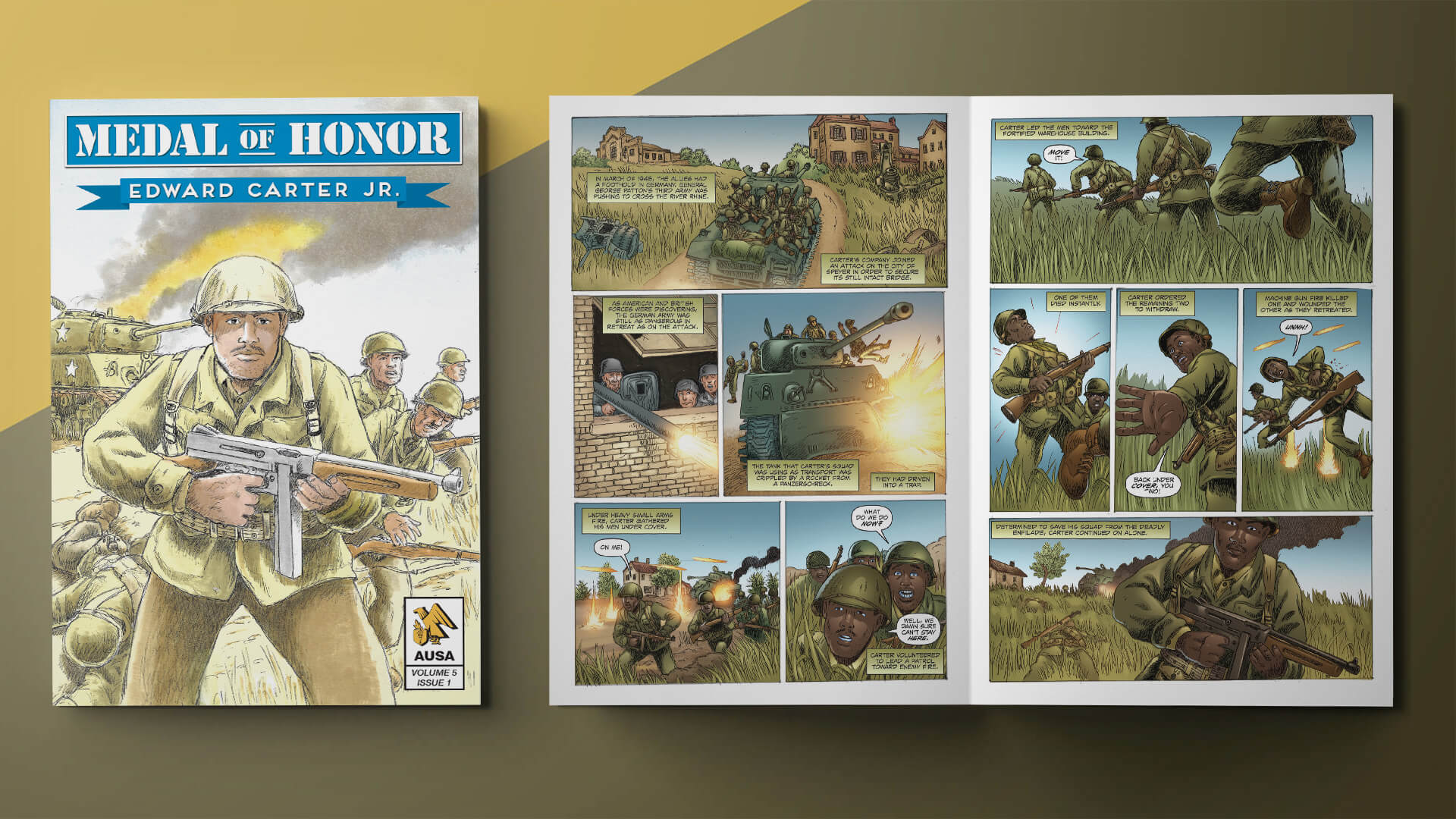New AUSA Graphic Novel Features World War II Hero
New AUSA Graphic Novel Features World War II Hero

Staff Sgt. Edward Carter Jr., who single-handedly fought the enemy while wounded and helped U.S. forces capture a nearby German town during World War II, is the focus of the latest graphic novel in the Association of the U.S. Army’s series on recipients of the nation’s highest award for valor.
Medal of Honor: Edward Carter Jr. tells of the Los Angeles native’s actions on March 23, 1945, near Speyer, Germany. It also highlights his incredible life before the Army.
“Carter’s life story is simply amazing—you could make a movie about his combat experience before he even joined the U.S. Army,” said Joseph Craig, director of AUSA’s Book Program. “The creative team has done a great job in introducing this man to the American public.”
Medal of Honor: Edward Carter Jr. is available here.
AUSA launched its Medal of Honor graphic novel series in October 2018. This is the 17th novel in the series, with three more planned this year along with a paperback collection to be released in the fall.
The digital graphic novels are available here.
Born in May 1916 to missionary parents, Carter was 9 when his family moved from Los Angeles to India to start a church. Every chance he had, Carter would sneak away to watch troops maneuver at a nearby British army base.
When the family moved to China, Carter’s father enrolled him in a Chinese military academy, further sharpening his desire to serve. In 1932, following a Japanese invasion, a 15-year-old Carter ran off and volunteered to serve in the Chinese army. His father found him after several weeks and brought him home.
He tried to fight again when the Italians attacked Ethiopia in 1935 and eventually traveled to Spain to fight in its civil war as part of the Abraham Lincoln Brigade.
After returning to the United States, Carter joined the U.S. Army in 1941, according to a tribute by the National World War II Museum. Relegated to a transportation unit, Carter would work his way up to staff sergeant.
He would get his chance to serve on the front lines after the horrific losses suffered during the Battle of the Bulge, according to the museum.
Assigned to the 1st Infantry Company Provisional, 7th Army, Carter and his fellow soldiers pushed toward the Rhine River. As they approached the town of Speyer, Carter and his men came under heavy enemy fire that disabled their tank.
The soldiers took cover, and Carter volunteered to lead a patrol to a warehouse 150 yards away across an open field where enemy German fighters were holed up, according to his Medal of Honor citation.
The patrol quickly came under heavy fire; one American was killed instantly. Carter ordered the other two soldiers to return to cover while he moved out alone.
Enemy fire killed one of the two remaining soldiers and seriously wounded the other. An enemy machine-gun burst hit Carter three times in the left arm, another wound in his left leg knocked him off his feet, and an enemy round tore through his left hand.
Undeterred, Carter kept moving forward until he was within 30 yards of the warehouse, the citation says. The enemy fire was so heavy that Carter took cover behind a bank and stayed there for two hours.
When eight enemy fighters approached Carter, apparently to take him prisoner, Carter killed six and captured the remaining two, the citation says.
The two enemy soldiers later gave the Americans valuable information about the number and disposition of enemy troops, allowing the Americans to capture the nearby town of Speyer.
After the war, Carter’s hopes of continuing to serve were dashed when the Army denied his reenlistment because of his previous associations in China and Spain, according to the National World War II Museum.
Carter fought the decision for years. He died heartbroken in January 1963. He was just 46.
In 1997, Carter was one of seven soldiers recognized with the Medal of Honor. They remain the only African American recipients of the award from World War II. “History has been made whole today, and our nation is bestowing honor on those who have long deserved it,” then-President Bill Clinton said during the Medal of Honor ceremony.
Each AUSA graphic novel is created by a team of professional comic book veterans. The script for the graphic novel on Carter was written by Chuck Dixon, whose previous work includes Batman, The Punisher and The ’Nam.
Pencils, inks and the cover were by Wayne Vansant, who has worked on The ’Nam, Savage Tales and All Quiet on the Western Front; colors were by Peter Pantazis, who previously worked on Justice League, Superman and Black Panther; and the lettering was by Troy Peteri, who has worked on Spider-Man, Iron Man and X-Men.

